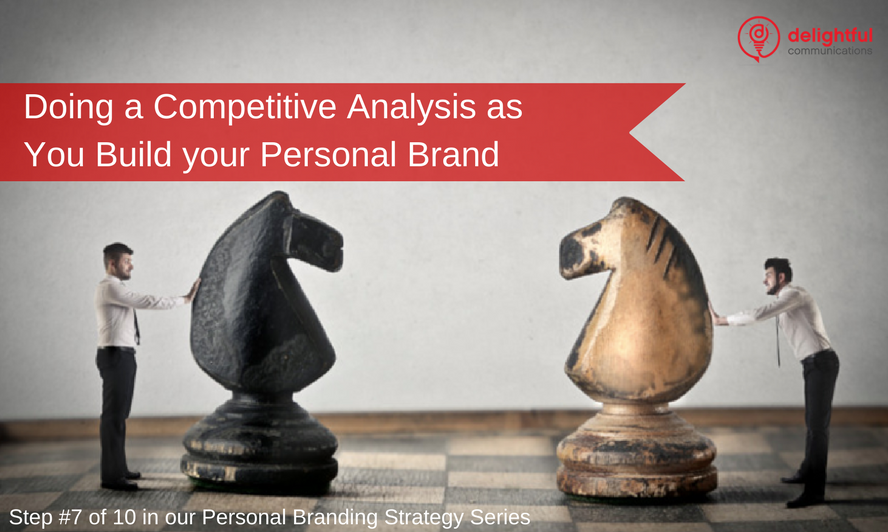When it comes to digital marketing per se, one of the biggest gaps I see companies unable to fill is the real-time understanding of what their competition is up to. During my sixteen years in digital, I’ll be the first to admit being so down in the weeds executing on the tactical plan that I’ve not had the wherewithal to run a competitive analysis and notice what my competition has been up to.
Having learned that lesson, one of the first things we do at Delightful with our clients is conduct a competitive analysis to see who’s out there, what they are doing well and where the opportunities are to differentiate and stand out.
Competitive analysis is as important for you and your personal brand as it is for the company you work for. Understanding what other people in your niche are doing, saying and how successful they are is crucial to personal branding success and here are a few things you can do to figure out who they are, their impact and what you can do to wrestle attention away from them and onto you.
Use LinkedIn to Research Your Industry
LinkedIn should be your first stop in the competitive analysis process. We use it to look for people with similar roles to our clients at similar businesses and see how well they are utilizing the platform. How well a person is using LinkedIn tells you a lot about how serious they are about their personal brand: Are they publishing content? How active are they on the platform liking and commenting on other people’s content? How robust is their profile? Have they filled out all the experience fields? Do they have a summary and, if so, how does it position them within your industry?
LinkedIn is a goldmine of competitive information to help understand who’s got what experience in your niche and how well they are engaging with their connections. Your presence should be a living profile that you update on a weekly basis because, in our experience, the number one blocker to anyone having a tip-top personal brand is time.
Make time to understand your competition on LinkedIn and make time to be engaging on a regular basis.
Mine Twitter for Like Minds
Use tools like Followerwonk or an influencer discovery tool like Traackr and BuzzSumo to figure out who’s influential in your field and study their footprint. How many followers do they have? What are they sharing? What’s their social ratio (how much of what they share is personal versus professional)? What’s their reach? What content seems to resonate best with their followers? Are they following as many people as are following them (always a good measure of authenticity in our opinion)?
Twitter is a great way to understand how others in your industry exude their personal brand in real-time and you can pick up tips from power-users on what content you should be sharing and, more importantly, how agile and engaging you should be with your following if you want to compete.
Listen Out for Where They Speak
What can be an indicator of influence in any industry is being invited to speak at conferences and events, so scour the speaker pages of conferences you know of to see who’s talking and about what. Do a search for their name and the conference on Google or Bing to see if anyone covered their speaking session to see what was written about them.
Try and understand their speech topics and extracts what their “angle” is and think of a way to differentiate or complement what they’re focusing on if it’s perilously close to your expertise. You don’t want to give a conference organizer any reason to reject any pitch of yours to speak, so make sure you know the lay of the speaker land.
Remember to be Qualitative
While the beauty of digital is the huge swathes of data it gives us to get stuck into number-crunching when analyzing anything, it’s also important to measure quality and not be swooned by big numbers. Combining a gut feel for the quality of the digital footprint your competitor may have with the amount of followers, engagement, content produced or shared etc etc, is far better than focusing on numbers alone.
Your number one goal by making your personal brand discoverable, shareable and memorable is to instill trust in anyone who discovers you or you engage with.
To quote Stephen R. Covey, author of the fantastic book The Speed of Trust:
“Trust is equal parts character and competence… You can look at any leadership failure, and it’s always a failure of one or the other.”
Being competent enough to know what your competition is doing with their personal brand will help you set your character apart from theirs and limit the chance of failure.
Remember to check back in a fortnight for the next installment in our series: How to Build a Personal Branding Strategy
And don’t forget to:
Check out our book now in paperback: Introduction to Personal Branding: 10 Steps Towards a New Professional You
Subscribe to The Personal Brand Lab
Like the Delightful Facebook Page
Cheers,
@MelCarson – Founder of Delightful

